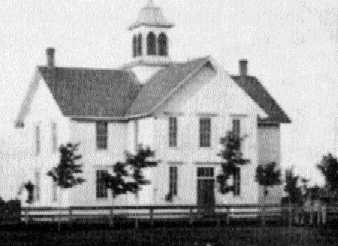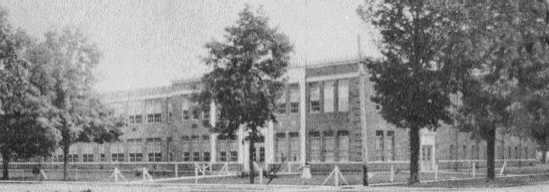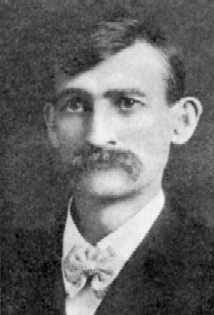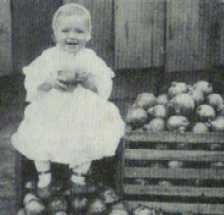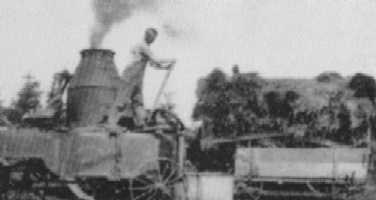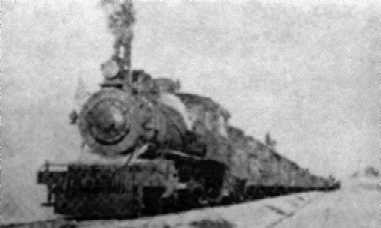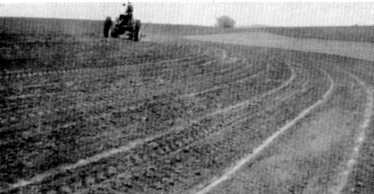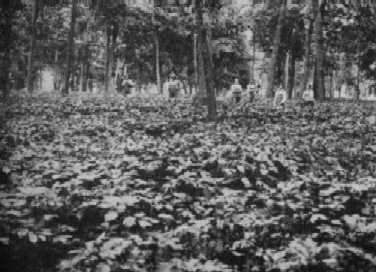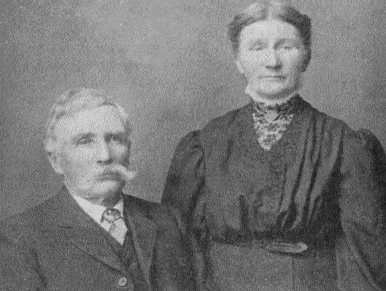SCHOOLS
Public Schools
The first school in Mitchell County was in private school taught by the Rev. Clausen at St. Ansgar in August 1853. It was
for religious instruction only.
The old stone school house, built in 1858
The educational problem was simple. A home served as a schoolhouse; the pastor or some other pioneer served as teacher. Miss Amelia Hirsch was the first hired teacher, and in 1853 the school was held in building on what, until recently, was the Benson farm.
The first school of the regular common school type was a log building erected by citizens of the village for school and church and other purposes. It was situated on Main Street just
west of the present Hugh Carr residence, formerly owned by R. C. Lubiens. In 1855, the school was taught by Miss Burt, for $16 per month.
Four room school, built in 1877, halls and
stairs in front part.
In 1858, this school was replaced by the stone schoolhouse erected on the corner where the Borsheim home now stands. School attendance grew rapidly. The enrollment at one time was more than a hundred, with one teacher. E. L. Sawyer was the teacher when the picture was taken in 1870.
As population increased, a new building became a necessity, and in 1877 the wooden structure which preceded the present school building was built. It had four rooms. It was twice enlarged. An Enterprise of 1878 names three departments in the school, and states that Prof. Houg would conduct a select high school in the same building, where common branches and languages would be taught.
Present public school building, houses grades and High school.
The present fine grade and high school building was erected in 1928. Today, in 1953, the facilities are again inadequate, and again we must plan for an increased school attendance. We do not doubt that needs will be met in the characteristic St. Ansgar way.
The St. Ansgar Academy
(Also called the Seminary)The St. Ansgar Academy was organized in 1877
as the St. Ansgar High School, with H. S. Houg in charge. The school was held upstairs in a building, which stood, in the location now occupied by the Lloyd Koch residence.
H.S. Houg, founder of the
St. Ansgar Academy
When the four-room public school was built about the same time, Mr. Houg availed himself of the opportunity to occupy room in the new building. He advertised "a select High school, offering common branches and languages."
The church was the pivot upon which the early community life turned, so it was but natural that the church officers should plan for higher education than that afforded by the public school. Plans were forwarded for the erection of a brick building, and by March 1882, it was an accomplished reality. Dedication services were held Oct. 10, 1882.
Until 1888, the school was known as the "St. Ansgar High School." Enterprise files (Enterprise 2-29-'88) state that the name was then changed to the "St. Ansgar Academy." It was familiarly called the Seminary.
That the work here was of a high standard is
indicated by the fact that in 1894, credits from here were accepted by the University of Minnesota without examination.
The St. Ansgar Academy,
dedicated October 10, 1882
The school was a tremendous influence far reaching not only in paths of book learning, but in the land of romance as well. Many homes of today are the results of romances which started at the "Old Sem."
On June 8, 1910, the Academy observed its 30th and last Commencement. That fall it failed to open. Today it lives only in the memories of students who attended there.
The building is now used as a Parish House for the First Lutheran Church.
Seminary Hall
In 1891 this dormitory was built on the southeast corner of the block, and was the home of the principal and a
rooming house for students. After the academy closed, the place was rented to various parties. Field laborers who came from away occupied it for some time. In 1936, the property was sold to Art Dietrich and Lawrence Rosenberg, who tore down the building and used it to build their present homes.
The Seminary Hall - the "Old Dorm"
The School Today
The educational program of the community is a growing one. It is based upon the child's needs to cope with a rapidly changing society and world.
The philosophy behind the teaching in the school is to help the child become an adult citizen with the ability to maintain an open mind, to use the logical approach to problems, to develop a problem solving attitude, to always be conscious and considerate of other people, to be able to make fine distinctions between the rights and wrongs in all things in life.
Today the school, at the secondary level, offers the opportunity to search and inquire into the areas of Science, Literature, Mathematics, Business Occupations, History, Homemaking, Agriculture, Music, Physical Development, and the Structure of Society. Students may, at the end of their ninth year, pursue knowledge in specially designed curricula for college preparation, General Education, Business Education, Agriculture, Homemaking, and Nursing.
The school serves a surrounding community that embraces approximately 112 sections of some of the choicest farmland in Iowa. The transportation system has grown to five large buses transporting an average of 205 pupils daily. At the present rate of enrollment growth, the number will likely grow to 7 or 8 large buses within the next five years.
The school offers the service of a low cost, nutritionally balanced, lunch program. Approximately 40,000 lunches will be served this schoolyear.
In the past year, the Music Program has been expanded from two part-time music instructors to two full-time instructors. The program has as its chief purpose the development of the esthetic and appreciative senses of children as the real value in music education.
The Athletic Program of the school strives to develop a keen competitive spirit in those who participate, and to give spectators and participants alike the opportunity to experience practicing the highest standards of sportsmanship. The physical education program is solely for the development of neuro-muscular skills, opening new ways for using leisure time, and for teaching good health habits.
School administrators endeavor to the best of their ability and in the interest of the overall welfare of the school and the community, to offer and to administer a complete modern program. They try to operate it as efficiently as possible and yet give the children a well-rounded educational program. It is a school of the people, by the people, and for the people to insure our way of life forever.
J. L. - C. H.
OUR GIFTS FROM THE SOIL
Agriculture
A hundred years of farming around St. Ansgar has brought many changes.
When the first settlers came in June, 1853, and settled along Red Cedar River, they found a river of
crystal clear water. Its tributaries, Deer Creek, Turtle Creek, and Beaver Creek, were spring fed and clear. Along the banks grew hardwood trees: walnut, maple, oak and elm, with some cedar. Back from these clear water streams the timber changed to hazelbrush and finally prairie grass, and land less rolling.
A child with some produce.
The present generation, will be interested in the progress agriculture has made these one hundred years, and how the early settlers solved their problems.
The first settlers were farmers. June was too late to sow wheat and expect to harvest a crop. Therefore the first crops sown by the first settlers were corn, rutabagas and potatoes. The most important crop planted in Mitchell County near St. Ansgar was corn, and it is still our most important crop.
That first winter of 1853-1854 the people lived on rutabagas, cornmeal bread and mush, potatoes and venison.
On Mikkel Tollefson's farm, 60 deer were killed that first winter.
Upright steam engine on Tollefson farm.
Luther Tollefson driving.When the first settlers started west from McGregor there were 75 people, 30 wagons, 150 cattle and 3 horses. Not all reached the St. Ansgar area. But from this information we know they had cattle. We also know they had oxen enough to pull 30 wagons, and had only 3 horses.
On the wagons were plows and hand tools, no other farm implements. With oxen and plows, they plowed hazelbrush and prairie land. To prepare for seeding and planting, they used brush as we now use a disc and harrow. Grain was sown by hand. In planting corn, a marker, consisting of three or four parallel pieces of wood,
46 inches apart and held in place by wooden braces across the markers, was used.
"Threshing at home; the 40 acres of oats
bought in shock from a neighbor with
onion money from two acres."
One or two men would pull this marker lengthwise and crosswise of the field. Where the marks crossed, the corn was planted, giving rows 46 inches both ways. Planting was done by making a hole where marks crossed and another person dropping the kernels of corn into the hole and covering.
The next improvement in corn planting was the hand planter. The marker was still used, but one man could plant and cover several acres a day. Next came the horse drawn planter with one man driving and one checking. Checking consisted of pulling a lever every time the planter shoe crossed a mark in the soil. Three or four kernels would drop as the lever was pulled.
Next came the wire, and now after one hundred years we drill or power check.
By 1866, crop yields in Mitchell County were reported-on spring wheat 13.7 bushels per acre; oats, 30.8; corn, 20.9; rye, from sorghum cane, 58.9 gallons, pounds of wool per sheep, 2.89. Land was assessed at $4.10 per acre.
Wheat was the cash crop. It was hauled by wagon and oxen to Decorah, West Union, McGregor and Cedar Falls and was sold or traded for whatever the settlers needed, usually salt, coffee, tools, hardware, etc., or something they could not make or grow themselves.
In 1860, Knud Tollefson took 35 bushels of wheat to McGregor to trade for a barrel of salt. It took all of his wheat plus $2.00 cash to pay for the barrel of salt.
One H. Benson hired his wheat hauled to McGregor. It cost him 30¢ a bushel to have it hauled and he received 35¢ a bushel for his wheat.
It took 15 days to go to McGregor and back by oxen and 8 days with horses.
In 1869, the Illinois Railroad was built and progress in agriculture became more rapid.
In November of 1878, farmers were receiving prices as follows: corn 20¢; oats 20¢; wheat 30-35¢; live hogs $2.00-$2.10; butter 12 1/2¢.
In April of 1890, prices quoted to farmers at St. Ansgar were as follows: live hogs $3.75-$3.80; fat steers $3.50-$3.75; good cows $2.50; oats 20¢; corn 20¢; wheat 68¢; eggs 10¢ a dozen.
In the fall of 1893, T. M. Tollefson had seed wheat for sale that tested 64 pounds. His yield was 38 bushels per acre.
By 1880 dairy farming had reached such importance that Samuel Moe and C. Hanson started a private creamery.
Dairy production grew to be an important farming enterprise from 1880 up to the present time. It started when the farmwomen had churned more butter than the family could consume and they took the surplus butter to the store to trade for groceries. In 1878, stores in St. Ansgar were paying 12%¢ for butter. Gradually farmers commenced to milk more cows. By 1887 the Farmers Creamery with G. A. Dutcher as buttermaker was producing 136,800 pounds of butter. The creamery sold the butter that year for an average of 24.3¢.
Dairy farming is still one of our important types of local farm production. After one hundred years, dairying has become a very specialized type of farming. Dairy cattle are bred, fed and managed to produce economically and efficiently. Milk is produced and handled on the farms under the most clean and sanitary methods possible. The times are past when farmers can milk a few cows and sell the cream without regard to sanitation and cost of production.
By 1878, live hogs were being sold at $2.00 to $2.10 per 100 pounds at St. Ansgar. Dressed hogs were also quoted at $2.75 to $3.00 per 100 pounds.
By 1890 hog production had become one of the chief sources of farm income. In February, March and April 1890 nearly one carload of hogs was shipped per day from St. Ansgar.
That same year 240 acres of land, the Nissen farm east of St. Ansgar, sold for $8,700.
About the same time cattle feeding or, as spoken of in the 90's it was "fattening cattle," was practiced by a few. Prices quoted were $3.50 to $3.80 for fat steers.
Wheat farming was being replaced by livestock farming 1890 to 1900.
After the turn of the century, Gilbertson and Son commenced to grow onions and strawberries on a large scale. About 1910 Frank Sedlacek commenced to grow potatoes as a cash crop. The quality
and quantity of vegetables grown in St. Ansgar area drew attention to this crop. Soon a number of people in and around St. Ansgar commenced to grow large acreages of potatoes, onions and cabbages.
Solid train loads of Mr. Sedlacek's stock on
the road to Chicago.In 1924 the Iowa Truck Growers Association was organized at a Truck Crop Growers meeting at St. Ansgar.
Much wealth was created in the St. Ansgar area during the truck crop era. However, cost of production increased as fertility decreased on the land used for truck crops. Plant insects and disease developed with the increase in truck farming. It finally became
a type of production that cost more than the product returned so this type of farming was largely abandoned.
Another view of F.J. Sedlacek's train. However, during the growing of truck crops extensively, St. Ansgar area became widely known as the "Garden Spot of Iowa." That name can be applied today as well, even though St. Ansgar area is a diversified farm community.
The wealth of St. Ansgar and vicinity is still found in its natural resource, the soil. The pioneers and ancestors of the present generation, after 100 years of producing wealth
in the form of food, have still left us an abundance of natural wealth in the soil.
Contour Farming
The fertile soils of the area are the divine gift in answer to the prayers of the early pioneers. When they asked for guidance to find a home in America, they were led to this area.
The beauty and productiveness of the St. Ansgar farming area are divine gifts. It is for us who now live to preserve and conserve these natural resources in all their beauty and productiveness so that we and it may be a blessing to future generations.
-- E.T.
Ginseng
The beginning of the ginseng industry dates back to late '90's when A. O. Gilbertson became interested in some
of these plants found in the wild state in our native timber.
A Ginseng arbor. Owner is A.O. Gilbertson,
son of G.G. Gilbertson.The industry had its inception in practically a handful of mother plants brought from the timber and transplanted into arbors. The small beginning grew from year to year until it constituted possibly the largest botanical gardens in the world. There were two combined arbors representing 48 1/2 acres of which 42 1/2 acres were planted to ginseng--the remaining 6 acres to golden seal. Both plants require shade and were grown in natural and in artificially shaded arbors.
It takes from ten to twelve years to
mature a crop of ginseng under natural shade as against seven to nine years under artificial shade, the quality being better under natural shade.
Mr. and Mrs. G.G. Gilbertson. Mr. Gilbertson
was called "Krop Krank Number One,"
producer of fancy onions and other
vegetables.
Gross returns from a four acre arbor of ginseng for the years '21, '22, and '23 were reportedly $18,056, $26,000 and $14,845. In 1924 root fibers sold for $2.50 per pound, and the best roots (fibers removed) brought from 12 to 14 dollars per pound. The seeds also sold at high prices. In the three years mentioned above, sales of seeds amounted to $42,000. All this from the four acre arbor.
© 2004 - Tracey Stickney-VanHise
HTMLization by Kermit Kittleson

